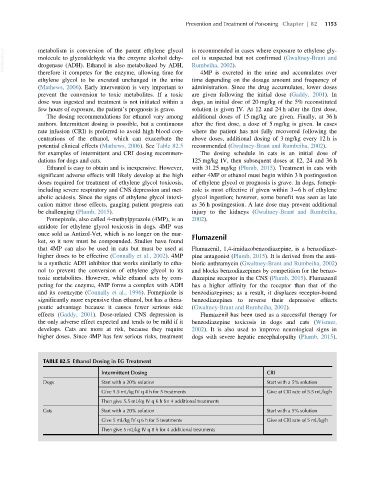Page 1222 - Veterinary Toxicology, Basic and Clinical Principles, 3rd Edition
P. 1222
Prevention and Treatment of Poisoning Chapter | 82 1153
VetBooks.ir metabolism is conversion of the parent ethylene glycol is recommended in cases where exposure to ethylene gly-
col is suspected but not confirmed (Gwaltney-Brant and
molecule to glycoaldehyde via the enzyme alcohol dehy-
Rumbeiha, 2002).
drogenase (ADH). Ethanol is also metabolized by ADH,
therefore it competes for the enzyme, allowing time for 4MP is excreted in the urine and accumulates over
ethylene glycol to be excreted unchanged in the urine time depending on the dosage amount and frequency of
(Mathews, 2006). Early intervention is very important to administration. Since the drug accumulates, lower doses
prevent the conversion to toxic metabolites. If a toxic are given following the initial dose (Gaddy, 2001). In
dose was ingested and treatment is not initiated within a dogs, an initial dose of 20 mg/kg of the 5% reconstituted
few hours of exposure, the patient’s prognosis is grave. solution is given IV. At 12 and 24 h after the first dose,
The dosing recommendations for ethanol vary among additional doses of 15 mg/kg are given. Finally, at 36 h
authors. Intermittent dosing is possible, but a continuous after the first dose, a dose of 5 mg/kg is given. In cases
rate infusion (CRI) is preferred to avoid high blood con- where the patient has not fully recovered following the
centrations of the ethanol, which can exacerbate the above doses, additional dosing of 3 mg/kg every 12 h is
potential clinical effects (Mathews, 2006). See Table 82.5 recommended (Gwaltney-Brant and Rumbeiha, 2002).
for examples of intermittent and CRI dosing recommen- The dosing schedule in cats is an initial dose of
dations for dogs and cats. 125 mg/kg IV, then subsequent doses at 12, 24 and 36 h
Ethanol is easy to obtain and is inexpensive. However, with 31.25 mg/kg (Plumb, 2015). Treatment in cats with
significant adverse effects will likely develop at the high either 4MP or ethanol must begin within 3 h postingestion
doses required for treatment of ethylene glycol toxicosis, of ethylene glycol or prognosis is grave. In dogs, fomepi-
including severe respiratory and CNS depression and met- zole is most effective if given within 3 6 h of ethylene
abolic acidosis. Since the signs of ethylene glycol intoxi- glycol ingestion; however, some benefit was seen as late
cation mirror those effects, gauging patient progress can as 36 h postingestion. A late dose may prevent additional
be challenging (Plumb, 2015). injury to the kidneys (Gwaltney-Brant and Rumbeiha,
Fomepizole, also called 4-methylpyrazole (4MP), is an 2002).
antidote for ethylene glycol toxicosis in dogs. 4MP was
once sold as Antizol-Vet, which is no longer on the mar- Flumazenil
ket, so it now must be compounded. Studies have found
that 4MP can also be used in cats but must be used at Flumazenil, 1,4-imidazobenzodiazepine, is a benzodiaze-
higher doses to be effective (Connally et al., 2002). 4MP pine antagonist (Plumb, 2015). It is derived from the anti-
is a synthetic ADH inhibitor that works similarly to etha- biotic anthramycin (Gwaltney-Brant and Rumbeiha, 2002)
nol to prevent the conversion of ethylene glycol to its and blocks benzodiazepines by competition for the benzo-
toxic metabolites. However, while ethanol acts by com- diazepine receptor in the CNS (Plumb, 2015). Flumazenil
peting for the enzyme, 4MP forms a complex with ADH has a higher affinity for the receptor than that of the
and its coenzyme (Connally et al., 1996). Fomepizole is benzodiazepines; as a result, it displaces receptor-bound
significantly more expensive than ethanol, but has a thera- benzodiazepines to reverse their depressive effects
peutic advantage because it causes fewer serious side (Gwaltney-Brant and Rumbeiha, 2002).
effects (Gaddy, 2001). Dose-related CNS depression is Flumazenil has been used as a successful therapy for
the only adverse effect expected and tends to be mild if it benzodiazepine toxicosis in dogs and cats (Wismer,
develops. Cats are more at risk, because they require 2002). It is also used to improve neurological signs in
higher doses. Since 4MP has few serious risks, treatment dogs with severe hepatic encephalopathy (Plumb, 2015).
TABLE 82.5 Ethanol Dosing in EG Treatment
Intermittent Dosing CRI
Dogs Start with a 20% solution Start with a 5% solution
Give 5.5 mL/kg IV q 4 h for 5 treatments Give at CRI rate of 5.5 mL/kg/h
Then give 5.5 mL/kg IV q 6 h for 4 additional treatments
Cats Start with a 20% solution Start with a 5% solution
Give 5 mL/kg IV q 6 h for 5 treatments Give at CRI rate of 5 mL/kg/h
Then give 5 mL/kg IV q 8 h for 4 additional treatments

